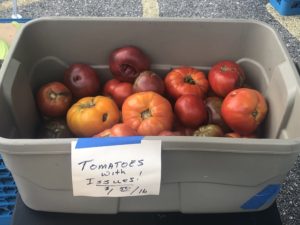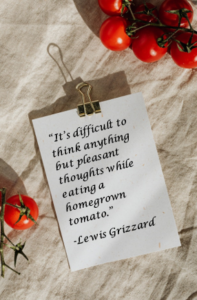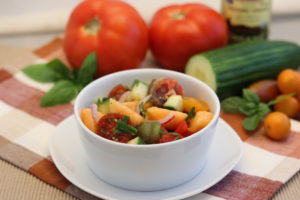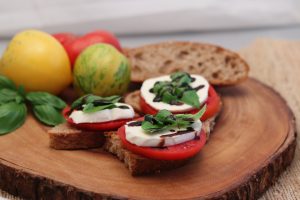We all know that flavor-exploding sweetness that comes from a perfectly ripe, freshly-picked tomato.
In many parts of the country, juicy delicious summer tomatoes are becoming abundantly available, either from your own garden or from your dedicated local farmers RIGHT NOW!
Just the thought of a fresh juicy tomato can make your mouth water, envisioning them as part of your favorite BLT sandwich, in an Heirloom Tomato Salad, in Tomato and Basil Bruschetta, on a flavor-popping Cherry Tomato Margherita Pizza…and the list goes on and on!
Let’s set the record straight…are tomatoes a vegetable or a fruit?
It depends who you ask! Botanically speaking, tomatoes are a fruit because the tomato is the edible fruit/berry of the tomato plant. Believe it or not, the U.S. Supreme Court weighed in on this debate, concluding tomatoes are vegetables. To make a long story short, vegetables were subject to a 10% tariff. An importer of tomatoes argued that tomatoes are a fruit and, therefore, not subject to the tax. While the Supreme Court acknowledged tomatoes are technically fruits, they concluded they are more like a vegetable in everyday life, usually served with savory dishes and not, like fruits, as dessert. So, now you can argue both sides of this debate!
Why tomatoes?
The health benefits can vary slightly between different types of tomatoes, but they are all nutritional powerhouses:
- Loaded with Vitamin C, Vitamin E, and antioxidants (especially lycopene), they are powerful cancer-fighters!
- Their high level of beta-carotene, can help prevent tumor development.
- With high potassium and low sodium, they help lower blood pressure and reduce the risk for cardiovascular disease.
- Rich in lycopene, lutein, and beta-carotene, they help protect your eyes and prevent age-related diseases.
Not all tomatoes are created equal!
Having experienced the incredible aroma and flavor of farm fresh and home-grown tomatoes, have you ever wondered why many tomatoes at supermarkets and restaurants are so “bland?”
You know the ones…that strange, crunchy variety you find on your burger or in your salad at some restaurants. Or the ones that look so tantalizing at the store, but just don’t deliver when you get them home, slice them and find them to be pale and lacking flavor. Why is this?
A big reason is many commercially-produced tomatoes have been bred for high yield and durability…not flavor.
- Those who produce and sell these tomatoes want them to be disease resistant, have a long shelf-life and be durable and uniform in shape to make them easier to transport.
- They also want them to ripen evenly…to become ripe all at once (which is not how an “explode in your mouth” tomato normally ripens).
- Often, these commercially-produced tomatoes are picked while they are green and immature, and then sprayed with ethylene gas to help turn them red. Then, they may be refrigerated during transit, killing whatever flavor may have existed. This process also means that the commercial varieties are deficient in nutrients compared to the farm or home-grown tomato that is naturally ripened and picked just before adding it into your meal.
So, buy local or grow your own when you can!
How do you pick the best ones?
 As with all produce, it is best to buy tomatoes that haven’t been treated with harmful pesticides.
As with all produce, it is best to buy tomatoes that haven’t been treated with harmful pesticides.
Select tomatoes that are brightly colored, with no bruises or soft spots, and avoid tomatoes with wrinkled skin. It’s also best to choose tomatoes that are firm and feel heavy for their size. A good aroma near the stem is also a good sign.
Tomatoes don’t need to look absolutely perfect…in fact, purchasing “seconds” or “still-good-but-on-the-verge-of-going-bad” tomatoes can be a fantastic bargain if you are using them immediately. They are ideal for making flavor-bursting Salsa Fresca or Marinara Sauce!
Should you refrigerate tomatoes?
We mentioned above that tomatoes may be refrigerated during transit, destroying whatever flavor existed. This is something to keep in mind when storing your tomatoes at home…it’s recommended not to refrigerate fresh tomatoes!
- Store them on the counter (in a bowl or on a plate is fine) at room temperature (or in a cool dark place if you have one).
- Try to keep them out of direct sunlight to prevent uneven ripening.
- Stem side up or down? It depends who you ask. We asked some local farmers we highly respect and they recommend keeping them stem side down. Since the top is the last part of the tomato to ripen, this helps them ripen more evenly. It arguably also reduces moisture leaving and air entering where the stem was removed. Test it out and see which method you like best.
- After you slice a tomato, you can store leftover slices in the refrigerator for a few days or at room temperature covered with plastic wrap. Although, your best bet would probably be to just go ahead and eat all the slices so there are no leftovers!
Freeze tomatoes?
To preserve the amazing tomato bounty this summer so you can enjoy them year-round, good and easy methods are to freeze, can or oven-dry the fruits. Tomatoes can be frozen whole, sliced, chopped or pureed. And you can store them raw or cooked. Keep in mind, when you use them after they have been frozen, you shouldn’t expect their texture to be the same as fresh — the freezing process will cause them to be mushier, but they should still have good flavor and can work great in recipes (especially recipes where the tomatoes are cooked). Don’t add any seasoning before freezing – the freezing process will weaken the flavor of the seasoning.
What about heirloom tomatoes?
This coaching tip wouldn’t be complete without mentioning one of our favorite types of tomatoes…heirloom tomatoes!
These are varieties passed down from several family generations. Some say to be an “heirloom,” they must have originated before 1940.
Heirloom tomatoes are softer and vary greatly in size and color – some of them have some crazy looking shapes! They also have some great names like Black Cherry, Brandywine, Chocolate Stripes, Cherokee Purple and Dixie Golden Giant! Because their cells rupture easily, they all have that “explode in your mouth” flavor!
Are canned tomatoes ok?
Absolutely! We try to take advantage of the remarkable flavor of fresh tomatoes when we can in the summer and, then, in the winter, maximize flavor by using canned tomatoes.
There are a variety of choices when it comes to canned tomatoes — just remember to read those ingredient labels to know exactly what you are getting! And make sure the cans are BPA-free. A general rule of thumb is one 28 oz can of tomatoes can be substituted for 10-12 whole fresh tomatoes, and one 14 oz can of tomatoes equals about 5-6 whole fresh tomatoes.
What can you do with fresh tomatoes?
We are continuing to provide delicious meal ideas throughout the summer to help you get as much enjoyment as possible out of fresh in-season tomatoes. Here are just a few great ideas:
Grilled Sweet and Spicy Summer Tomatoes
Take Me to Italy Tomato & Garlic Pasta
Baked Cod with Herbed Tomato Sauce
Try tomatoes in some new ways this summer!
And try some new varieties that you haven’t tried before. They will be abundantly available for the next couple months – so make the most of it while you can!
And remember, incredible fresh flavor goes beyond just tomatoes…the same difference can be found in all the other produce available from hard-working local farmers!
 LEARN MORE ABOUT THE NAPKIN!
LEARN MORE ABOUT THE NAPKIN!



Leave A Comment